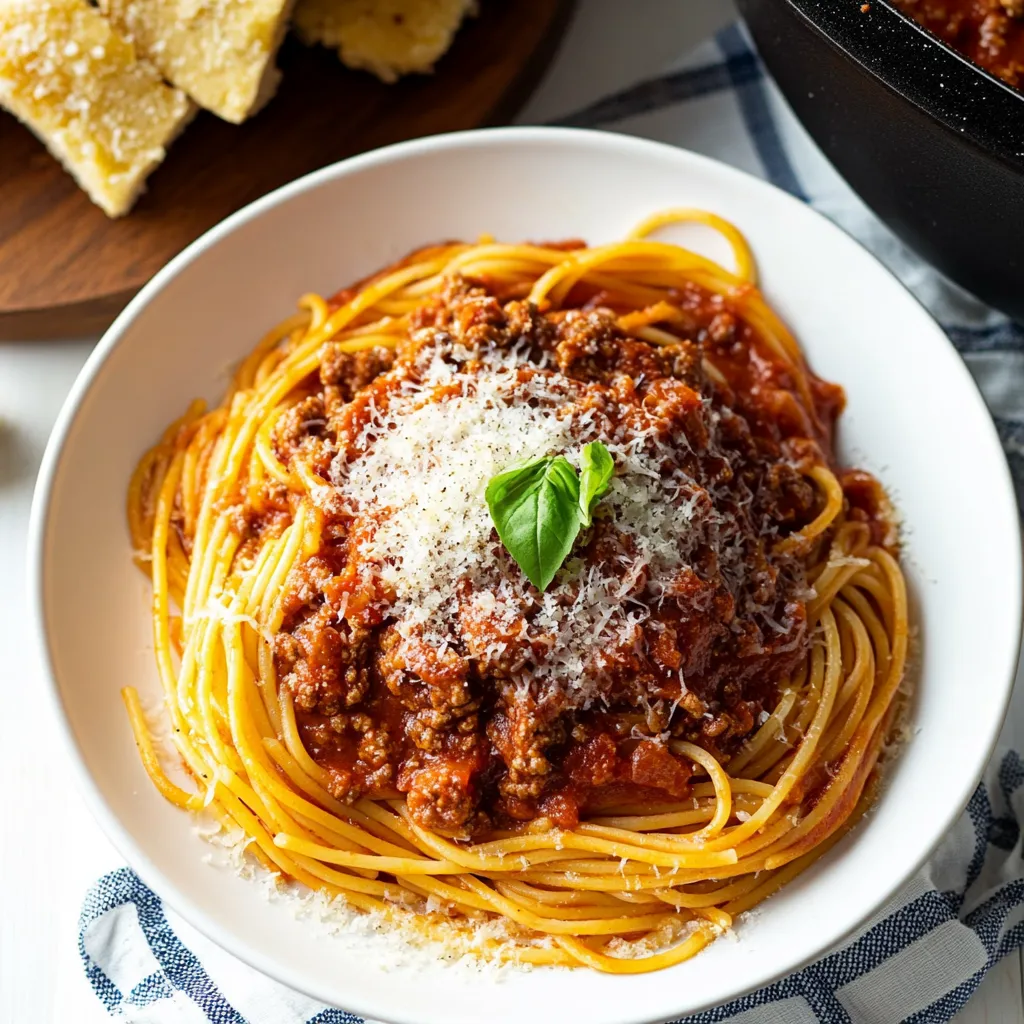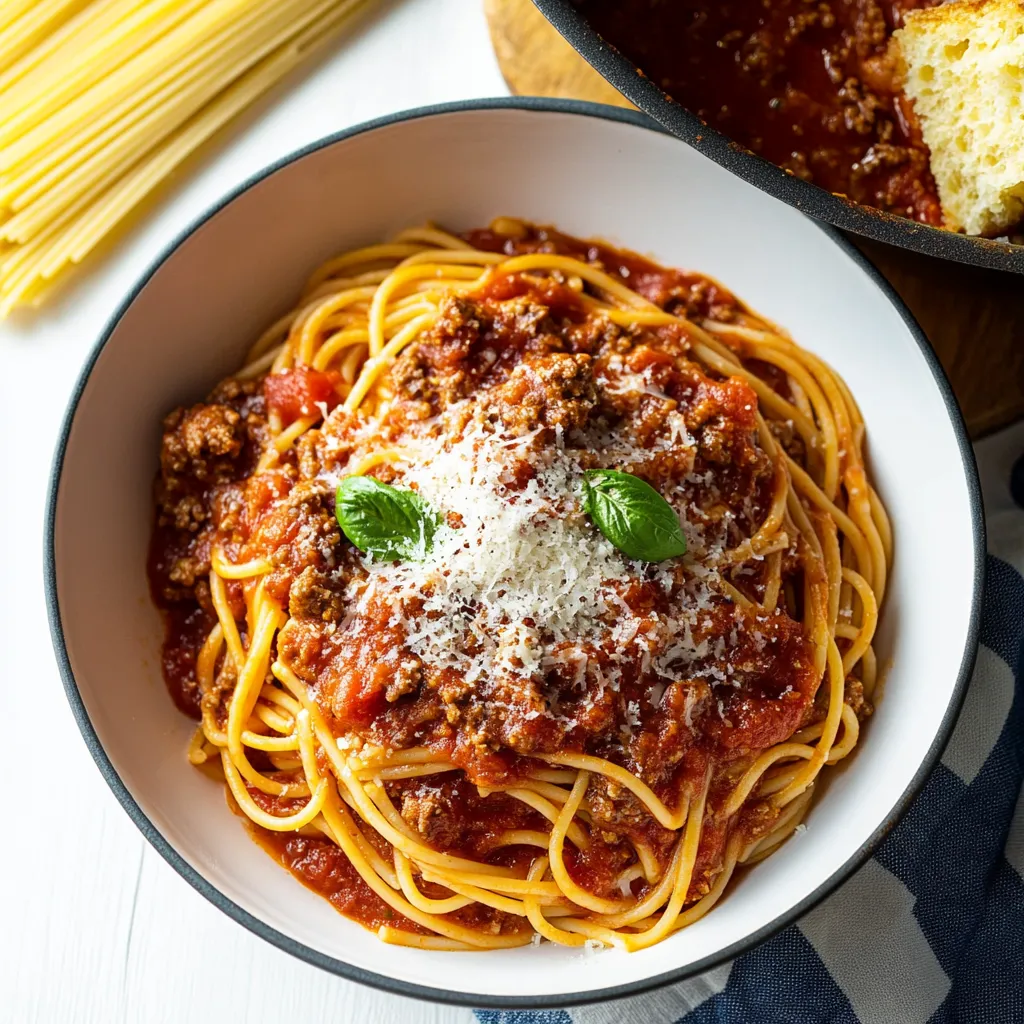 Bookmark
Bookmark
This homemade spaghetti sauce transforms ordinary pasta night into something truly special. Richly flavored with ground beef, aromatic herbs, and the perfect balance of tomatoes, it's a recipe I've perfected over years of Sunday family dinners.
I started making this sauce when I first moved away from home, missing my mother's traditional recipe. After dozens of iterations and happy accidents, this version has become my signature dish that friends constantly request the recipe for.
Ingredients
- Extra virgin olive oil provides the perfect foundation for building flavors and a silky texture
- Lean ground beef adds hearty protein while keeping the sauce from becoming greasy
- Yellow onion creates essential aromatic base notes that develop during cooking
- Garlic fresh cloves deliver that unmistakable Italian flavor profile
- Tomato paste concentrates the tomato flavor and thickens the sauce naturally
- Chicken stock adds depth that water simply cannot provide
- Crushed tomatoes provide the perfect texture balance between chunky and smooth
- Granulated sugar balances acidity without making the sauce sweet
- Dried herbs basil and oregano are the classic Italian flavor combination
- Salt and pepper essential for bringing all flavors into harmony
Step-by-Step Instructions
- Build the Flavor Base
- Heat olive oil in a large pot over medium-high heat until it shimmers slightly. Add ground beef, breaking it into small crumbles with a wooden spoon. Add the finely diced onions and minced garlic, stirring occasionally to prevent burning. Cook for 6-8 minutes until the beef loses all pinkness and the onions become translucent. This foundation layer provides essential savory notes.
- Develop Depth
- Add tomato paste to the meat mixture and stir continuously for one full minute. This brief cooking period caramelizes the tomato paste, transforming its raw flavor into something deeper and more complex. The paste will darken slightly and coat the meat evenly.
- Create the Sauce
- Pour in the chicken stock, crushed tomatoes, sugar, dried basil, dried oregano, salt, and black pepper. Stir thoroughly to incorporate all ingredients, making sure to scrape any browned bits from the bottom of the pot. These contain concentrated flavor. Bring the mixture to a full boil over high heat, then immediately reduce to a gentle simmer where small bubbles occasionally break the surface.
- Simmer to Perfection
- Allow the sauce to simmer uncovered for 20-30 minutes, stirring occasionally to prevent sticking. During this time, the liquid will reduce slightly, flavors will meld together, and the sauce will thicken to the perfect consistency. Taste and adjust seasoning with additional salt or pepper as needed before serving.
 Bookmark
Bookmark
The tomato paste is truly the secret weapon in this recipe. I once skipped it thinking the crushed tomatoes would be enough, and the sauce lacked that distinctive richness that makes this version so special. My family immediately noticed the difference and requested I "never skip the paste again!"
Make-Ahead and Storage
This spaghetti sauce actually improves with time as the flavors continue to meld. Make a double batch and store portions in airtight containers in the refrigerator for up to 5 days. For longer storage, let the sauce cool completely before transferring to freezer-safe containers. Leave about an inch of headspace for expansion and freeze for up to 3 months. Thaw overnight in the refrigerator before reheating gently on the stovetop.
Customize Your Sauce
The beauty of this recipe lies in its adaptability. For a vegetarian version, simply omit the ground beef and use vegetable broth instead of chicken stock. Add finely diced carrots and celery with the onions for additional flavor and nutrition. For a spicier variation, incorporate red pepper flakes or a dash of cayenne. Wine lovers can deglaze the pan with half a cup of dry red wine after browning the meat for an elevated flavor profile.
Serving Suggestions
While this sauce shines on traditional spaghetti, its versatility extends far beyond. Use it as a base for homemade lasagna, stuffed shells, or baked ziti. Spoon it over roasted spaghetti squash for a lower-carb option, or use it as a dipping sauce for garlic bread. For a complete meal, serve pasta and sauce with a simple green salad dressed with lemon and olive oil, and warm crusty bread for sopping up every last bit of sauce.
Recipe FAQs
- → Can I make this spaghetti sauce ahead of time?
Yes! This sauce actually improves with time as flavors meld together. Make it up to 3-4 days ahead and store in an airtight container in the refrigerator. For longer storage, freeze portions for up to 3 months in freezer-safe containers.
- → What can I use instead of ground beef?
Ground turkey, chicken, or Italian sausage work wonderfully as substitutes. For a vegetarian version, try plant-based ground meat alternatives or finely chopped mushrooms, which provide a similar texture and umami flavor.
- → How can I make this sauce thicker?
To thicken the sauce, simmer uncovered for an additional 10-15 minutes, allowing more liquid to evaporate. Alternatively, add an extra tablespoon of tomato paste during cooking. For a quicker fix, create a slurry with 1 tablespoon cornstarch mixed with 2 tablespoons cold water and stir into the simmering sauce.
- → Can I use fresh herbs instead of dried?
Absolutely! Substitute the dried herbs with 1 tablespoon each of fresh chopped basil and oregano. If using fresh herbs, add them during the last 5-10 minutes of cooking to preserve their vibrant flavor and color.
- → What's the best pasta to serve with this sauce?
This hearty meat sauce pairs perfectly with spaghetti, fettuccine, or pappardelle, as these long noodles hold the chunky sauce well. For something different, try it with rigatoni or penne, where the sauce can get trapped inside the tubular shapes for flavor-packed bites.
- → Why add sugar to spaghetti sauce?
The small amount of sugar helps balance the acidity of the tomatoes, creating a more rounded flavor profile. If you prefer to avoid refined sugar, you can substitute with a tablespoon of honey, maple syrup, or simply omit it if using naturally sweeter tomatoes.
